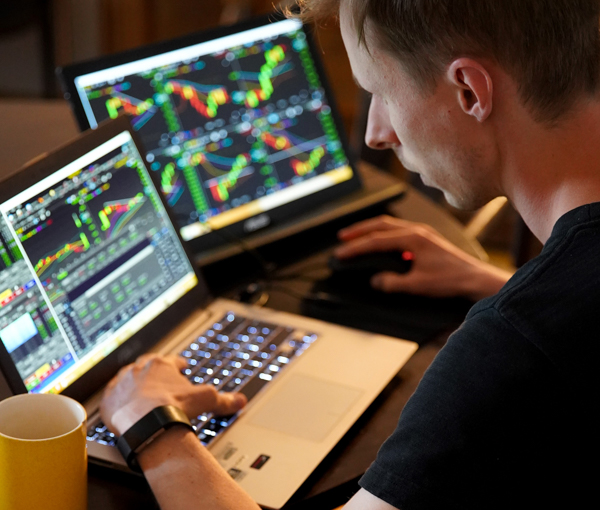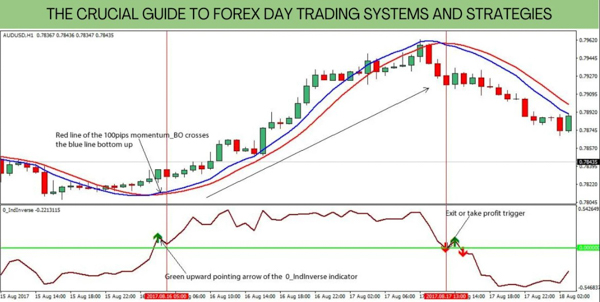Forex trading provides a chance to participate in a global economy with great potential. Because of its popularity among day traders, Forex has earned a reputation for producing rapid returns. In reality, it is just as complicated and competitive as any other global marketplace. To not only succeed, but to succeed consistently, you must first comprehend the market and then fine-tune your trading technique.
In this post, we will define day trading before delving into the numerous day trading methods and systems that are available and how traders utilize them to earn. We will also provide some recommendations on how to locate the ideal day trading plan for 2022 and provide some beneficial trading ideas!

1. Fundamental definitions about Forex day trading system and strategies that you need to know
1.1. What is day trading?
Day trading is the practice of opening and closing positions on the same day. Day trading tactics are more action-packed and need traders being at their trading station throughout the session to follow the live price charts.
It is commonly understood that the shorter the time period in which a trader operates, the greater danger they are likely to be exposed to, making day trading one of the riskiest approaches to the financial markets.
1.2. What is Forex Day Trading System and Forex Day Trading Strategy?
There are several Forex day trading systems. Nevertheless, they should not be confused with day trading strategies. The primary distinction between a system and a strategy is that a system specifies a trading approach, but a strategy is more descriptive and gives more precise information, such as entry and exit locations, indicators, and time periods.
1.2.1. How many types of Forex Day Trading Systems?
Below is a quick review of four most often utilized Forex Day Trading Systems (please note that scalping, fading, and momentum are also Forex Day Trading Strategies):
- Scalping: In this system, buying or selling occurs immediately after the deal becomes profitable. The goal of this trading style is to achieve profitability while you are just up a few pips. You might anticipate to trade a lot and create a lot of money. However, the profit per transaction is rather little.
- Fading: Fading is a system in which equities, an index, or a currency pair are shorted shortly after an upward advance. When buyers begin to enter the market again, the price goal is set in this type of day trading. In other words, you want to profit from market actions that attempt to recover an asset’s previous price.
- Daily Pivots: Profit is made in this technique by using the volatility of asset values on a daily basis. The purchasing or selling occurs at the low phase of the day, and the trade is closed during the high period of the day. The price objective here follows the same trend as described earlier.
- Momentum: In this sort of Forex Day Trading Systems, trading is generally done on the basis of news releases or by detecting powerful moves that are trending and are supported by big volumes. In this approach, the price goal is reached when the volume begins to decline and bearish candles appear. You are normally seeking to buy an asset a few hours before news is out, and then sell it once the market has moved sufficiently in your favor.
1.2.2. How many types of Forex Day Trading Strategies?
The following are five of the most commonly used Forex Day Trading Strategies:
- Trend trading: Trend traders try to earn money by examining the direction of asset prices and then purchasing or selling based on the direction of the trend. If the trend is upward, with prices reaching successive higher highs, traders would establish a long position and purchase the asset. If the trend is downward, with prices making successive lower lows, traders would sell to take a short position.
- Swing trading: Swing trading is all about taking advantage of short-term price patterns, using the notion that prices in a trend never travel in one way. Swing traders, on the other hand, seek to benefit from both up and down moves that occur in a shorter time period. While trend traders strive to profit from long-term market trends, swing traders are more interested in minor price reversals in a market. They try to anticipate these reversals and trade to profit from minor market fluctuations.
- Scalping: Scalping is a short-term trading method that focuses on having a high win rate by taking tiny but frequent profits. The notion is that you can create a large trading account just as readily by taking modest profits repeatedly as you can by executing fewer trades and seeking to lock in earnings in the long term. Scalping necessitates a disciplined exit plan since losses might quickly offset earnings. Because the reduced profit margins from each transaction are swiftly eroded by overnight funding charges, most scalpers will exit positions before the end of the day.
- Mean reversion: Mean reversion is the belief that prices, and other measures of value such as price-to-earnings (P/E) ratios, will always return to the historical mean. The method employs technical analysis techniques such as moving averages to identify assets whose recent performance has deviated significantly from their historical average. Mean reversion traders will then profit from the return to their usual trajectory.
- Money flows: The money flow indicator indicates if an asset is oversold or overbought by combining volume and price rather than just the asset’s price. It determines whether the money flow was positive or negative by comparing the number of deals from the previous day to the current day. A rating of 80 or higher indicates overbought circumstances and should be sold by the trader. A value of 20 or less implies oversold market conditions and is a buy signal.
2. How do I determine if I am a Forex day trader?
You can take a self-check with a checklist below:
- You may be a forex day trader if you:
- You enjoy starting and finishing a deal on the same day.
- You have time to evaluate the markets in the morning and can follow them throughout the day.
- At the end of the day, you want to know if you won or lost.
- You may not be a forex day trader if you:
- You prefer long-term or short-term trading.
- You don’t have time to examine and watch the markets throughout the day.
- You work during the day.

3. How to start day trading Forex?
- To begin trading right now, open a genuine account or practice risk-free with virtual cash on our demo account.
- Choose between spread betting and CFD trading as your product.
- Investigate the forex market and consult our day trading guide for success ideas and methods.
- Brush up on your technical analysis skills by studying price charts and technical indicators.
- To preserve your capital, use risk-management instruments such as stop-loss orders.
4. How do Forex Day Traders make money?
Day traders use big amounts of cash to profit from slight price swings in highly liquid indices, equities, or currencies. In other words, these traders are not seeking for significant price falls and peaks. They are OK with little, moderate swings, but their transactions are greater and more frequent than those generated by traders who invest for longer periods of time. The primary goal of a day trader is to generate a large number of pips in a single day.

Day traders should ideally earn profits on both asset highs and lows in forex day trader strategies. The entry in the various systems employ comparable tools to those used in conventional trading; the only variation is in the time and approach.
5. What are the most profitable forex trading strategy for beginners?
After determining a time frame, the intended position size on a single trade, and the anticipated number of transactions you want to open during a specific time period, we’ll go through three prominent Forex trading strategies for beginners that have shown to be profitable.
5.1 Scalping
Forex scalping is a popular trading method that focuses on minor market fluctuations. This approach entails opening a huge number of transactions in the hopes of making tiny returns on each one.
Hence, scalpers strive to maximize earnings by making a high number of minor gains. This method is diametrically opposed to remaining in a posture for hours, days, or even weeks.
Because of the liquidity and volatility of the Forex market, scalping is quite popular. Investors are seeking markets where the price movement is continually shifting in order to profit from modest variations.
5.2 Day Trading
The process of exchanging currencies in a single trading day is referred to as day trading. Day trading method, while applicable in all markets, is most commonly utilized in Forex. This trading strategy suggests that you open and close all deals in a single day.
To reduce risk, no position should be left open overnight. Unlike scalpers, who only want to stay in markets for a few minutes, day traders typically monitor and manage open deals throughout the day. Day traders produce trading ideas mostly using 30-minute and 1-hour time periods.
Many day traders base their trading methods on breaking news. Scheduled events, such as economic figures, interest rates, GDPs, elections, and so on, have a significant influence on the market.

5.3 Position Trading
Position trading is a long-term investment technique. This trading method, unlike scalping and day trading, is primarily concerned with basic variables.
Minor market swings are not taken into account in this technique since they have little impact on the overall market picture.
To detect cyclical patterns, position traders are likely to study central bank monetary policies, political developments, and other fundamental variables. Successful position traders may only open a few transactions every year. However, profit goals in these trades are likely to be in the hundreds of pips range.
6. To sump up: Key highlights about Forex Day Trading Systems and Strategies
- The practice of starting and closing trades on the same day is known as day trading. Day trading strategies are more action-packed and need traders to stay at their trading station throughout the session in order to monitor the live price charts.
- A system differs from a strategy in that it outlines a trading technique, but a strategy is more descriptive and provides more exact information.
- The four most common Forex Day Trading Systems are: Scalping, Fading, Daily Pivots and Momentum.
- The five most common Forex Day Trading Strategies are: Trend Trading, Day Trading, Scalping, Mean reversion, Money flows.
- The most profitable Forex day trading strategies for beginners (can be changed in the future) are: Scalping, Day Trading, Position Trading.



